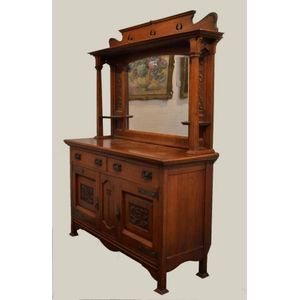Art Nouveau Walnut Sideboard with Mirrored Back
You must be a subscriber, and be logged in to view price and dealer details.
Subscribe Now to view actual auction price for this item
When you subscribe, you have the option of setting the currency in which to display prices to $Au, $US, $NZ or Stg.
- Column - An architectural feature sometimes used for decorative effect and sometimes as part of the supporting construction. Columns should generally taper slightly towards the top. They may be plain or decorated with carving, fluting or reeding. Columns may be fully rounded or, more commonly, half-rounded and attached with glue, screws or pins to the outer stiles of doors, or the facing uprights on cabinets and bureaux.
- Panels - Timber pieces, usually of well-figured wood either recessed or applied over the frames of doors and as decoration elsewhere in the carcase of cabinet furniture. The panels may take a variety of shapes rectangular, square, shield shape, oval, half-round or in the form of Egyptian pylons.
- Drop Handles - In furniture of the late 17th and early 18th centuries, small metal drop handles were often used, frequently in a pear or tear shape. The back plate, to which the drop was attached, may be either a simple plain circle, or in the form of a star or diamond. These handles have been widely reproduced, and are frequently found on Jacobean and Queen Anne style furniture made after the first world war. Reproduction handles can usually be identified by the inferior quality of the metal used during the 1920s and 1930s, sometimes thinly coated with brass or copper, though modern copies are often of excellent quality.
- Art Nouveau Period - The Art Nouveau period was a cultural movement that emerged in the late 19th century, and was characterized by its emphasis on natural forms, flowing lines, and a decorative, ornamental style. Art Nouveau was a reaction against the ornate and heavily stylized designs of the previous era, and sought to create a new, more organic aesthetic.
Art Nouveau was characterized by its use of sinuous, curving lines, as well as a focus on natural elements such as flowers, vines, and other organic shapes. Art Nouveau designers sought to create a total work of art, in which every element of a building or object was designed to be harmonious with the overall design.
Some of the most iconic examples of Art Nouveau design include the Paris Metro entrances designed by Hector Guimard, the works of the artist Alphonse Mucha, and the architecture of Victor Horta in Brussels.
The Art Nouveau period was at its peak between 1890 and 1910, but began to decline in popularity by the start of World War I. However, Art Nouveau remains an important influence on design and art to this day, and continues to be celebrated for its emphasis on natural forms and decorative style. - Bevel / Chamfer - In furniture making, a chamfered corner refers to a technique used to create a smooth, angled edge on the corner of a piece of furniture. This is typically done by cutting away a small portion of the corner at an angle, typically 45 degrees, creating a diagonal edge, rather than a sharp 90-degree angle. This technique can be used on various parts of a piece of furniture such as table legs, drawer fronts, or door frames. Chamfering can add visual interest to a piece and can help to soften the overall look of a piece of furniture. It is often used in conjunction with other techniques, such as rounding edges or using contrasting wood species to create a more elegant, sophisticated look. Chamfering is a simple way to add a touch of elegance to a piece of furniture and it is a common technique used by furniture makers.
This item has been included into following indexes:
- cabinets, material - walnut 670
- cabinets, period or style - Art Nouveau 32
-
sideboards
- Art Nouveau 18
- mirror back 138
Visually similar items

A mahogany Napoleon III bedside table, late 1880s, the table with a red and white veined marble inset top above a panelled drawer and an open compartment supported on fluted pillars, a panelled cupboard below with paterae flanked by fluted panels, raised o

A late Victorian walnut sideboard, circa 1880, maker W Walker Sons Bunill row London .E .C the moulded cornice above mirrors and shelves the lower section with a pair of drawers flanked by small drawers and carved panel doors. 220 cm high, 213 cm wide, 63

A Victorian burr walnut and ebony inlay music cabinet c.1880-1890. The cabinet has a mirrored back with top upper shelf which is decorated with a brass fretwork gallery. The lower cupboard has two glazed doors with two interior shelves, upon turned spindle

A Federation pine duchess dressing table, four drawers to base and two jewellry drawers and a swing mirror 170 cm high, 90 cm wide, 45 cm deep
